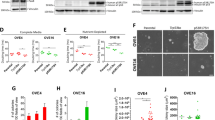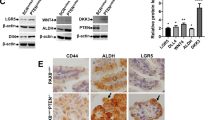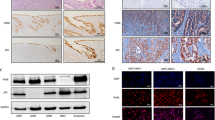Abstract
High grade serous carcinoma (HGSC) is the most common subtype of ovarian cancer and it is now widely accepted that this disease often originates from the fallopian tube epithelium. PAX8 is a fallopian tube lineage marker with an essential role in embryonal female genital tract development. In the adult fallopian tube, PAX8 is expressed in the fallopian tube secretory epithelial cell (FTSEC) and its expression is maintained through the process of FTSEC transformation to HGSC. We now report that PAX8 has a pro-proliferative and anti-apoptotic role in HGSC. The tumor suppressor gene TP53 is mutated in close to 100% of HGSC; in the majority of cases, these are missense mutations that endow the mutant p53 protein with potential gain of function (GOF) oncogenic activities. We show that PAX8 positively regulates the expression of TP53 in HGSC and the pro-proliferative role of PAX8 is mediated by the GOF activity of mutant p53. Surprisingly, mutant p53 transcriptionally activates the expression of p21, which localizes to the cytoplasm of HGSC cells where it plays a non-canonical, pro-proliferative role. Together, our findings illustrate how TP53 mutations in HGSC subvert a normal regulatory pathway into a driver of tumor progression.
This is a preview of subscription content, access via your institution
Access options
Subscribe to this journal
Receive 50 print issues and online access
$259.00 per year
only $5.18 per issue
Buy this article
- Purchase on Springer Link
- Instant access to full article PDF
Prices may be subject to local taxes which are calculated during checkout






Similar content being viewed by others
References
Piek JM, van Diest PJ, Zweemer RP, Jansen JW, Poort-Keesom RJ, Menko FH, et al. Dysplastic changes in prophylactically removed fallopian tubes of women predisposed to developing ovarian cancer. J Pathol. 2001;195:451–6.
Medeiros F, Muto MG, Lee Y, Elvin JA, Callahan MJ, Feltmate C, et al. The tubal fimbria is a preferred site for early adenocarcinoma in women with familial ovarian cancer syndrome. Am J Surg Pathol. 2006;30:230–6.
Perets R, Drapkin R. It’s totally tubular….riding the new wave of ovarian cancer research. Cancer Res. 2015;76:10–7.
Bowen NJ, Logani S, Dickerson EB, Kapa LB, Akhtar M, Benigno BB, et al. Emerging roles for PAX8 in ovarian cancer and endosalpingeal development. Gynecol Oncol. 2007;104:331–7.
Chi N, Epstein JA. Getting your Pax straight: Pax proteins in development and disease. Trends Genet. 2002;18:41–7.
Mansouri A, Chowdhury K, Gruss P. Follicular cells of the thyroid gland require Pax8 gene function. Nat Genet. 1998;19:87–90.
Mittag J, Winterhager E, Bauer K, Grummer R, Congenital hypothyroid female pax8-deficient mice are infertile despite thyroid hormone replacement therapy. Endocrinology. 2007;148:719–25.
Laury AR, Hornick JL, Perets R, Krane JF, Corson J, Drapkin R, et al. PAX8 reliably distinguishes ovarian serous tumors from malignant mesothelioma. Am J Surg Pathol. 2010;34:627–35.
Laury AR, Perets R, Piao H, Krane JF, Barletta JA, French C, et al. A comprehensive analysis of PAX8 expression in human epithelial tumors. Am J Surg Pathol. 2011;35:816–26.
Nonaka D, Chiriboga L, Soslow RA. Expression of pax8 as a useful marker in distinguishing ovarian carcinomas from mammary carcinomas. Am J Surg Pathol. 2008;32:1566–71.
Li CG, Nyman JE, Braithwaite AW, Eccles MR, PAX8 promotes tumor cell growth by transcriptionally regulating E2F1 and stabilizing RB protein. Oncogene. 2011;30:4824–34.
Rodgers LH, Ó hAinmhire E, Young AN, Burdette JE, Loss of PAX8 in high-grade serous ovarian cancer reduces cell survival despite unique modes of action in the fallopian tube and ovarian surface epithelium. Oncotarget. 2016;7:32785–95.
Elias KM, Emori MM, Westerling T, Long H, Budina-Kolomets A, Li F, et al. Epigenetic remodeling regulates transcriptional changes between ovarian cancer and benign precursors. JCI insight. 2016;1:e87988.
Kar SP, Adler E, Tyrer J, Hazelett D, Anton-Culver H, Bandera EV, et al. Enrichment of putative PAX8 target genes at serous epithelial ovarian cancer susceptibility loci. Br J Cancer. 2017;116:524–35. http://www.ncbi.nlm.nih.gov/pubmed/28103614. Accessed 14 Feb 2017.
Lee Y, Miron A, Drapkin R, Nucci MR, Medeiros F, Saleemuddin A, et al. A candidate precursor to serous carcinoma that originates in the distal fallopian tube. J Pathol. 2007;211:26–35.
Ahmed AA, Etemadmoghadam D, Temple J, Lynch AG, Riad M, Sharma R, et al. Driver mutations in TP53 are ubiquitous in high grade serous carcinoma of the ovary. J Pathol. 2010;221:49–56.
TCGA. Integrated genomic analyses of ovarian carcinoma. Nature. 2011;474:609–15..
Perets R, Wyant G, Muto K, Bijron J, Poole B, Chin K, et al. Transformation of the fallopian tube secretory epithelium leads to high-grade serous ovarian cancer in Brca;Tp53;Pten Models. Cancer Cell. 2013;24:751–65.
Carcangiu ML, Radice P, Manoukian S, Spatti G, Gobbo M, Pensotti V, et al. Atypical epithelial proliferation in fallopian tubes in prophylactic salpingo-oophorectomy specimens from BRCA1 and BRCA2 germline mutation carriers. Int J Gynecol Pathol. 2004;23:35–40.
Bijron JG, Seldenrijk CA, Zweemer RP, Lange JG, Verheijen RHM, van Diest PJ. Fallopian tube intraluminal tumor spread from noninvasive precursor lesions: a novel metastatic route in early pelvic carcinogenesis. Am J Surg Pathol. 2013;37:1123–30.
Bieging KT, Attardi LD, Brady CA, Attardi LD, Vousden KH, Prives C, et al. Deconstructing p53 transcriptional networks in tumor suppression. Trends Cell Biol. 2012;22:97–106.
Olive KP, Tuveson DA, Ruhe ZC, Yin B, Willis NA, Bronson RT, et al. Mutant p53 gain of function in two mouse models of Li-Fraumeni syndrome. Cell. 2004;119:847–60.
Brachova P, Thiel KW, Leslie KK. The consequence of oncomorphic TP53 mutations in ovarian cancer. Int J Mol Sci. 2013;14:19257–75.
Quartuccio SM, Karthikeyan S, Eddie SL, Lantvit DD, Ó hAinmhire E, Modi DA, et al. Mutant p53 expression in fallopian tube epithelium drives cell migration. Int J Cancer. 2015;137:1528–38.
Iwanicki MP, Chen H-Y, Iavarone C, Zervantonakis IK, Muranen T, Novak M, et al. Mutant p53 regulates ovarian cancer transformed phenotypes through autocrine matrix deposition. JCI insight. 2016;1:e86829.
Stuart ET, Haffner R, Oren M, Gruss P. Loss of p53 function through PAX-mediated transcriptional repression. EMBO J. 1995;14:5638–45.
Li X, Cheung KF, Ma X, Tian L, Zhao J, Go MYY, et al. Epigenetic inactivation of paired box gene 5, a novel tumor suppressor gene, through direct upregulation of p53 is associated with prognosis in gastric cancer patients. Oncogene. 2012;31:3419–30.
El-Deiry WS, Tokino T, Velculescu VE, Levy DB, Parsons R, Trent JM, et al. WAF1, a potential mediator of p53 tumor suppression. Cell. 1993;75:817–25.
Mhawech-Fauceglia P, Wang D, Samrao D, Godoy H, Ough F, Liu S, et al. Pair Box 8 (PAX8) protein expression in high grade, late stage (stages III and IV) ovarian serous carcinoma. Gynecol Oncol. 2012;127:198–201.
Ordonez NG. Value of PAX 8 immunostaining in tumor diagnosis: a review and update. Adv Anat Pathol. 2012;19:140–51.
Domcke S, Sinha R, Levine DA, Sander C, Schultz N. Evaluating cell lines as tumour models by comparison of genomic profiles. Nat Commun. 2013;4:2126.
Cheung HW, Cowley GS, Weir BA, Boehm JS, Rusin S, Scott JA, et al. Systematic investigation of genetic vulnerabilities across cancer cell lines reveals lineage-specific dependencies in ovarian cancer. Proc Natl Acad Sci USA. 2011;108:12372–7.
Barretina J, Caponigro G, Stransky N, Venkatesan K, Margolin AA, Kim S, et al. The cancer cell line encyclopedia enables predictive modelling of anticancer drug sensitivity. Nature. 2012;483:603–7.
Yaginuma Y, Westphal H. Abnormal structure and expression of the p53 gene in human ovarian carcinoma cell lines. Cancer Res. 1992;52:4196–9.
Hua G, Lv X, He C, Remmenga SW, Rodabough KJ, Dong J, et al. YAP induces high-grade serous carcinoma in fallopian tube secretory epithelial cells. Oncogene. 2016;35:2247
Harper JW, Adami GR, Wei N, Keyomarsi K, Elledge SJ. The p21 Cdk-interacting protein Cip1 is a potent inhibitor of G1 cyclin-dependent kinases. Cell. 1993;75:805–16.
Satyanarayana A, Hilton MB, Kaldis P. p21 inhibits Cdk1 in the absence of Cdk2 to maintain the G1/S phase DNA damage checkpoint. Mol Biol Cell. 2008;19:65–77.
Cayrol C, Knibiehler M, Ducommun B. p21 binding to PCNA causes G1 and G2 cell cycle arrest in p53-deficient cells. Oncogene. 1998;16:311–20.
Abbas T, Dutta A, p21 in cancer: intricate networks and multiple activities. Nat Rev Cancer. 2009;9:400–14.
Zhou BP, Liao Y, Xia W, Spohn B, Lee MH, Hung MC. Cytoplasmic localization of p21Cip1/WAF1 by Akt-induced phosphorylation in HER-2/neu-overexpressing cells. Nat Cell Biol. 2001;3:245–52.
Asada M, Yamada T, Ichijo H, Delia D, Miyazono K, Fukumuro K, et al. Apoptosis inhibitory activity of cytoplasmicp21(Cip1/WAF1) in monocytic differentiation. EMBO J. 1999;18:1223–34.
Lee S, Helfman DM. Cytoplasmic p21Cip1 is involved in Ras-induced inhibition of the ROCK/LIMK/cofilin pathway. J Biol Chem. 2004;279:1885–91.
Zhan T, Rindtorff N, Boutros M. Wnt signaling in cancer. Oncogene. 2016;36:1461–73.
Oren O, Smith BD. Eliminating cancer stem cells by targeting embryonic signaling pathways. Stem Cell Rev. 2016;13:17–23.
Chan DW, Hui WWY, Wang JJ, Yung MMH, Hui LMN, Qin Y, et al. DLX1 acts as a crucial target of FOXM1 to promote ovarian cancer aggressiveness by enhancing TGF-β/SMAD4 signaling. Oncogene. 2016;36:1404–16.
Blake JA, Ziman MR.Pax genes: regulators of lineage specification and progenitor cell maintenance. Development. 2014;141:737–51.
Wistuba J, Mittag J, Luetjens CM, Cooper TG, Yeung C-H, Nieschlag E, et al. Male congenital hypothyroid Pax8-/- mice are infertile despite adequate treatment with thyroid hormone. J Endocrinol. 2007;192:99–109.
Tung CS, Mok SC, Tsang YTM, Zu Z, Song H, Liu J, et al. PAX2 expression in low malignant potential ovarian tumors and low-grade ovarian serous carcinomas. Mod Pathol. 2009;22:1243–50.
Al-Hujaily EM, Tang Y, Yao D-S, Carmona E, Garson K, Vanderhyden BC Divergent roles of PAX2 in the etiology and progression of ovarian cancer. Cancer Prev Res. 2015;8:1163–73.
Shah S, Schrader KA, Waanders E, Timms AE, Vijai J, Miething C, et al. A recurrent germline PAX5 mutation confers susceptibility to pre-B cell acute lymphoblastic leukemia. Nat Genet. 2013;45:1226–31.
Liu W, Li X, Chu ESH, Go MYY, Xu L, Zhao G, et al. Paired box gene 5 is a novel tumor suppressor in hepatocellular carcinoma through interaction with p53 signaling pathway. Hepatology. 2011;53:843–53.
Au AY, McBride C, Wilhelm KG,Jr, Koenig RJ, Speller B, Cheung L, et al. PAX8-peroxisome proliferator-activated receptor gamma (PPARgamma) disrupts normal PAX8 or PPARgamma transcriptional function and stimulates follicular thyroid cell growth. Endocrinology. 2006;147:367–76.
Tong GX, Devaraj K, Hamele-Bena D, Yu WM, Turk A, Chen X. et al. Pax8: a marker of carcinoma of Müllerian origin in serous effusions. Diagn Cytopathol. 2011;39:567–74.
Bass AJ, Thorsson V, Shmulevich I, Reynolds SM, Miller M, Bernard B, et al. Comprehensive molecular characterization of gastric adenocarcinoma. Nature. 2014;513:202–9.
Chang K, Creighton CJ, Davis C, Donehower L, Drummond J, Wheeler D, et al. The cancer genome atlas pan-cancer analysis project. Nat Genet. 2013;45:1113–20.
Doberstein K, Wieland A, Lee SBB, Blaheta RAA, Wedel S, Moch H, et al. L1-CAM expression in ccRCC correlates with shorter patients survival times and confers chemoresistance in renal cell carcinoma cells. Carcinogenesis. 2011;32:262–70. http://www.ncbi.nlm.nih.gov/pubmed/21097529. Accessed 1 Mar 2011.
Rowan S, Ludwig RL, Haupt Y, Bates S, Lu X, Oren M, et al. Specific loss of apoptotic but not cell-cycle arrest function in a human tumor derived p53 mutant. EMBO J. 1996;15:827–38.
Xia X, Ji T, Liu R, Weng Y, Fang Y, Wang Z, et al. Cytoplasmic p21 is responsible for paclitaxel resistance in ovarian cancer A2780 cells. Eur J Gynaecol Oncol. 2015;36:662–6.
Perets R, Kaplan T, Stein I, Hidas G, Tayeb S, Avraham E, et al. Genome-wide analysis of androgen receptor targets reveals COUP-TF1 as a novel player in human prostate cancer. PLoS ONE. 2012;7:e46467.
Blecher-Gonen R, Barnett-Itzhaki Z, Jaitin D, Amann-Zalcenstein D, Lara-Astiaso D, Amit I. High-throughput chromatin immunoprecipitation for genome-wide mapping of in vivo protein-DNA interactions and epigenomic states. Nat Protoc. 2013;8:539–54.
Acknowledgements
The work presented here was funded by The Israel Science Foundation (1901/13), Israel Cancer Research Fund, The European Commission (PCIG13-GA-2013-618174), Israel Cancer Association (20150894, 20170117), The women’s health grant at Rambam (all to R.P.), Dr. Miriam and Sheldon G. Adelson Medical Research Foundation (to M.O.), Israel Science Foundation (822/12) (to S.L.), The Hymen Milgrom Trust (to S.L.). We would like to thank Prof. Ronny Drapkin (University of Pennsylvania) for FT237 immortalized FTSEC line and Prof. Reuven Agami (AVL, Nederland Cancer Institute) for retroviral p21 shRNA construct.
Author information
Authors and Affiliations
Corresponding author
Ethics declarations
Conflict of interest
The authors declare that they have no competing interests.
Electronic supplementary material
Rights and permissions
About this article
Cite this article
Ghannam-Shahbari, D., Jacob, E., Kakun, R.R. et al. PAX8 activates a p53-p21-dependent pro-proliferative effect in high grade serous ovarian carcinoma. Oncogene 37, 2213–2224 (2018). https://doi.org/10.1038/s41388-017-0040-z
Received:
Revised:
Accepted:
Published:
Issue Date:
DOI: https://doi.org/10.1038/s41388-017-0040-z
This article is cited by
-
SOX17 and PAX8 constitute an actionable lineage-survival transcriptional complex in ovarian cancer
Oncogene (2022)
-
Targeting the DIO3 enzyme using first-in-class inhibitors effectively suppresses tumor growth: a new paradigm in ovarian cancer treatment
Oncogene (2021)
-
Chloroxine overrides DNA damage tolerance to restore platinum sensitivity in high-grade serous ovarian cancer
Cell Death & Disease (2021)
-
PAX8 plays an essential antiapoptotic role in uterine serous papillary cancer
Oncogene (2021)
-
Overview of PAX gene family: analysis of human tissue-specific variant expression and involvement in human disease
Human Genetics (2021)



